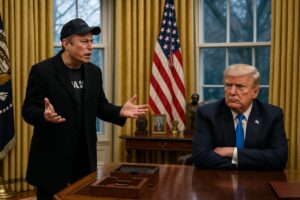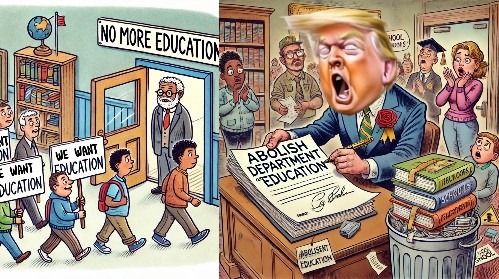President Donald Trump is moving forward with an executive order aimed at the closure of the USA Department of Education, aiming to transfer educational control to individual states. This initiative comes as recent studies highlight that more than half of Americans between the ages of 16 and 74 read below a sixth-grade level, raising concerns about the nation’s educational standing. The order will direct the Secretary of Education to outline a closure strategy, setting off a 90-day review process with input from Congress. Linda McMahon, the administration’s nominee for Secretary of Education, is expected to oversee the transition if confirmed by the Senate.
This initiative is part of President Donald Trump’s broader effort to downsize the federal government and shift more power to individual states. The administration argues that decentralizing education policy will lead to more localized decision-making, allowing states to tailor education programs to their unique needs. However, critics fear that eliminating the department will weaken federal oversight and lead to disparities in educational quality across the country.
Legal Opposition Facing Closure of the USA Department of Education
The proposed closure of the USA Department of Education faces significant legal and political obstacles. Many of its programs, including special education services and Title I grants for disadvantaged students, are mandated by federal law. Any substantial changes would require congressional approval, making a complete shutdown unlikely without bipartisan support.
Furthermore, recent polls suggest that a majority of Americans, including many Republicans, oppose dismantling the department. Lawmakers from swing districts may be hesitant to back a measure that is unpopular with their constituents. Additionally, education advocacy groups and teachers’ unions, such as the American Federation of Teachers, have voiced strong opposition. Randi Weingarten, the union’s president, has indicated a willingness to discuss the administration’s plans but remains skeptical about their potential impact on public education.
Connection to Broader Government Restructuring Efforts
The push for closure of the USA Department of Education is part of a larger effort by the Trump administration to restructure or downsize federal agencies. The administration has targeted the United States Agency for International Development (USAID), accusing it of misusing federal funds. Elon Musk, who heads a cost-cutting advisory group working with the White House, has been vocal about reducing waste in government spending.
Critics argue that these measures are driven by ideology rather than efficiency. They point to previous attempts to cut the Education Department’s budget during Trump’s first term, which ultimately failed due to congressional resistance. Instead of reducing funding, Congress increased the department’s budget, underscoring the difficulty of achieving major structural changes through executive orders alone.
Implications for the Future of American Education
If Trump eventually achieves the closure of the USA Department of Education, responsibility for education policy will fall entirely to the states. Supporters of the move argue that this will lead to more innovation and flexibility in education. However, opponents warn that it could exacerbate educational inequality, as wealthier states may be able to invest more in schools while poorer states struggle to provide basic resources.
Additionally, the administration’s push for “patriotic” education and investigations into universities’ policies suggest a broader agenda beyond cost-cutting. These initiatives raise concerns about political influence in education and the potential erosion of federal protections for students, particularly those from marginalized communities.
As the White House prepares to move forward with its executive order, the coming weeks will determine whether this proposal gains traction or faces insurmountable political resistance.














